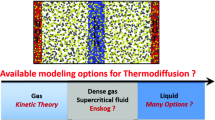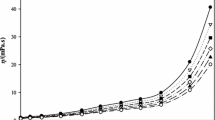Abstract
The objective of this work is the estimation of thermal conductivities for binary and ternary liquid mixtures using an excess thermal conductivity model. Firstly, calculation methods for thermal conductivities of ideal solutions are discussed using four models, including mole fraction average, One intuitively similar to Eyring’s model for kinematic viscosity and mass fraction average. Next, the Wilson-ThermConduct model was applied as the excess thermal conductivity model. The binary parameters in the model were determined from non-aqueous and aqueous binary thermal conductivity data. The prediction of the thermal conductivities for the ternary systems was done using the binary parameters of the binary constituent systems. The model presented in this work gave a 0.66% average absolute relative deviation of overall datasets. The evaluated results were compared with those using the mass fraction average (ideal) model, the Vredeveld’s power-law model, and Rowley’s local composition model with NRTL parameters determined from VLE data.







Similar content being viewed by others
Abbreviations
- AAD:
-
Average absolute deviation (W·m−1·K−1)
- AARD:
-
Average absolute relative deviation (%)
- F obj :
-
Objective function
- G :
-
Gibbs free energy
- G ij :
-
Binary parameter of the NRTL model
- k :
-
Eyring’s empirical constant
- M :
-
Molecular weight
- NC:
-
Number of components
- NDP:
-
Number of data points
- PR:
-
Peng–Robinson
- PT:
-
Patel–Teja
- R :
-
Gas constant = 8.314 (J·mol−1·K−1)
- T :
-
Temperature (K)
- TC:
-
Thermal conductivity
- w :
-
Liquid mass fraction
- x :
-
Liquid mole fraction
- λ:
-
Thermal conductivity (W·m−1·K−1)
- Λij, Λji :
-
Parameter in the Wilson-ThermConduct model
- Δ1 :
-
Absolute deviation between experimental and calculated thermal conductivities (W·m−1·K−1) defined as λexptl.− λcalcd.
- Δ2 :
-
Relative deviation between experimental and calculated thermal conductivities defined as (λexptl.− λcalcd.)/λexptl.
- E:
-
Excess property
- 1, 2, i, j :
-
Components 1, 2, i, and j
- calcd.:
-
Calculated
- exptl.:
-
Experimental
- max.:
-
Maximum
References
Hagiwara, K., Arai, Y.: Measurement and prediction of thermal conductivity of liquid organic compounds. Netsu Bussei 1(2), 52–61 (1987)
Heckenberger, T., Stephan, K.: Cubic equations of state for transport properties: an equation for the thermal conductivity of oxygen. Int. J. Thermophys. 11(6), 1011–1023 (1990)
Heckenberger, T., Stephan, K.: Cubic equations of state for transport properties. Int. J. Thermophys. 12(2), 333–356 (1991)
Guo, X.Q., Sun, C.Y., Rong, S.X., Chen, G.J., Guo, T.M.: Equation of state analog correlations for the viscosity and thermal conductivity of hydrocarbons and reservoir fluids. J. Pet. Sci. Eng. 30(1), 15–27 (2001)
Amooey, A.A.: A simple correlation to predict thermal conductivity of supercritical carbon dioxide. J. Supercrit. Fluids 86, 1–3 (2014)
Hopp, M., Gross, J.: Thermal conductivity of real substances from excess entropy scaling using PCP-SAFT. Ind. Eng. Chem. Res. 56(15), 4527–4538 (2017)
Khosharay, S., Khosharay, K., Nicola, G.D., Pierantozzi, M.: Modelling investigation on the thermal conductivity of pure liquid, vapour, and supercritical refrigerants and their mixtures by using Heyen EOS. Phys. Chem. Liq. 56(1), 124–140 (2018)
Cardona, L.F., Forero, L.A., Velásquez, J.A.: Correlation and prediction of thermal conductivity using the Redlich-Kwong cubic equation of state and the geometric similitude concept for pure substances and mixtures. Ind. Eng. Chem. Res. 58(51), 23417–23437 (2019)
Najafi, A.M., Hamzehie, E., Najibi, H., Soleimani, M., Gerven, T.V., Bruggen, B.V.D., Mazinani, S.: Thermal conductivity prediction of pure liquids using multi-layer perceptron neural network. J. Thermophys. Heat Transf. 29, 197–202 (2015)
Pierantozzi, M., Petrucci, G.: Modeling thermal conductivity in refrigerants through neural networks. Fluid Phase Equilib. 460, 36–44 (2018)
Cardona, L.F., Valderrama, J.O.: Physical and transport properties of ionic liquids using the geometric similitude concept and a cubic equation of state. Part 1: thermal conductivity and speed of sound of pure substances. J. Mol. Liq. 315, 113681 (2020)
Cardona, L.F., Valderrama, J.O.: Physical and transport properties of ionic liquids using geometric similitude and a cubic equation of state. Part 2: thermal conductivity, and speed of sound of water + ionic liquid mixtures. J. Mol. Liq. 317, 113926 (2020)
Niksirat, M., Aeenjan, F., Khosharay, S.: Introducing hydrogen bonding contribution to the Patel-Teja thermal conductivity equation of state for hydrochlorofluorocarbons, hydrofluorocarbons and hydrofluoroolefins. J. Mol. Liq. 351, 118631 (2022)
Quiñones-Cisneros, S.E., Pollak, S., Schmidt, K.A.G.: Friction theory model for thermal conductivity. J. Chem. Eng. Data 66(11), 4215–4227 (2021)
Li, C.C.: Thermal conductivity of liquid mixtures. AIChE J. 22(5), 927–930 (1976)
Poling, B.E., Prausnitz, J.M., O’Connell, J.P.: The Properties of Gases and Liquids, 5th edn. McGraw-Hill, New York (2001)
Rowley, R.L.: A local composition model for multicomponent liquid mixture thermal conductivities. Chem. Eng. Sci. 37(6), 897–904 (1982)
Rowley, R.L.: Ternary liquid mixture thermal conductivities. Chem. Eng. Sci. 43(2), 361–371 (1988)
Wang, P., Anderko, A.: Modeling thermal conductivity of concentrated and mixed-solvent electrolyte systems. Ind. Eng. Chem. Res. 47(15), 5698–5709 (2008)
Glasstone, S., Laidler, K. J., Eyring, H.: The Theory of Rate Processes, translated by S. Hasegawa, N. Hirai, H. Goto. McGraw-Hill, New York, 1941 (Chapter 9) Yoshioka Shoten, Tokyo (1964)
Tochigi, K., Mizuta, T., Yoshino, K.: Proceedings of the 5th International Symposium on Separation Technology—Korea and Japan, Seoul, 19–21 August 1999
Tochigi, K., Yoshino, K., Rattan, V.K.: Prediction of kinematic viscosities for binary and ternary liquid mixtures with an ASOG-VISCO group contribution method. Int. J. Thermophys. 26(2), 413–419 (2004)
Tochigi, K., Okamura, T., Rattan, V.K.: Prediction of high-pressure viscosities for binary liquid mixtures using the EOS-GE mixing rule with low-pressure viscosity data. Fluid Phase Equilib. 257(2), 228–232 (2007)
Matsuda, H., Kurihara, K., Tochigi, K., Funazukuri, T., Rattan, V.K.: Estimation of kinematic viscosities for CO2 expanded liquids by ASOG-VISCO model. Fluid Phase Equilib. 470, 188–192 (2018)
Matsuda, H., Tochigi, K., Kurihara, K., Funazukuri, T., Rattan, V.K.: Estimation of kinematic viscosities for multi-component systems using modified Eyring and activity coefficient model. Fluid Phase Equilib. 492, 137–144 (2019)
Powell, R.E., Roseveare, W.E., Eyring, H.: Diffusion, thermal conductivity, and viscous flow of liquids. Ind. Eng. Chem. 33(4), 430–435 (1941)
Wilson, G.: Vapor-liquid equilibrium. XI. A new expression for the excess free energy of mixing. J. Am. Chem. Soc. 86(2), 127–130 (1964)
Stephan, K., Hildwein, H.: Recommended Data of Selected Compounds and Binary Mixtures, DECHEMA Chemistry Data Series, vol. IV, Parts 1 and 2, Frankfurt (1987)
Ogiwara, K., Arai, Y., Saito, S.: Thermal conductivities of liquid hydrocarbons and their binary mixtures. Ind. Eng. Chem. Fundam. 19(3), 295–300 (1980)
Ogiwara, K., Arai, Y., Saito, S.: Thermal conductivities of liquid alcohols and their binary mixtures. J. Chem. Eng. Jpn. 15(5), 335–342 (1982)
Qun-Fang, L., Rui-Sen, L., Dan-Yan, N., Yu-Chun, H.: Thermal conductivities of some organic solvents and their binary mixtures. J. Chem. Eng. Data 42(5), 971–974 (1997)
Assael, M.J., Charitidou, E., Wakeham, W.A.: Absolute measurements of the thermal conductivity of mixtures of alcohols with water. Int. J. Thermophys. 10(4), 793–803 (1989)
Rowley, R.L., White, G.L.: Thermal conductivities of ternary liquid mixtures. J. Chem. Eng. Data 32(1), 63–69 (1987)
Jamieson, D.T., Irving, J.B., Tudhope, J.S.: The Thermal Conductivity of Liquids: A Survey to 1973. HMSO, London (1974)
Derr, E.L., Deal, C.H.: Institution of Chemical Engineers Symposium Series, vol. 32, Chapter 3, pp. 40. Institution of Chemical Engineers, London (1969)
Kojima, K., Tochigi, K.: Prediction of Vapor–Liquid Equilibria by ASOG Method. Kodansha-Elsevier, Tokyo (1979)
Tochigi, K., Tiegs, D., Gmehling, J., Kojima, K.: Determination of new ASOG parameters. J. Chem. Eng. Jpn. 23(4), 453–463 (1990)
Tochigi, K., Gmehling, J.: Determination of ASOG parameters-extension and revision. J. Chem. Eng. Jpn. 44(5), 304–306 (2011)
Tochigi, K., Matsuda, H., Kojima, K., Funazukuri, T., Rattan, V.K.: Abstract of JCEJ 2020 Annual Meeting, Online (2020)
Tochigi, K., Matsuda, H., Kojima, K., Funazukuri, T.: Abstract of 2020 AIChE Annual Meeting, Online (2020)
Novak, L.T.: Modeling the viscosity of liquid mixtures: polymer-solvent systems. Ind. Eng. Chem. Res. 42(8), 1824–1826 (2003)
Xu, Y., Tang, X., Li, J., Zhu, X.: Viscosity estimation of ternary mixtures containing ionic liquid from their binary subsystems: a comparison of three viscosity equations. Fluid Phase Equilib. 427, 166–174 (2016)
Gmehling, J., Onken, U., Arlt, W., Grenzheuser, P., Weidlich, U., Kolbe, B., Rarey, J.: DECHEMA Chemistry Data Series, vol. I. DECHEMA (1980–1990)
Author information
Authors and Affiliations
Contributions
HM and KT contributed to conceptualization, formal analysis, investigation, methodology, software, and writing—original draft preparation; KT contributed to data curation; HM and KK contributed to funding acquisition and resources; HM contributed to project administration; KT and TF contributed to supervision; TF contributed to validation; KT contributed to visualization; KK and TF contributed to writing—review and editing.
Corresponding author
Ethics declarations
Conflict of interest
There is no conflict of interest to declare.
Additional information
Publisher's Note
Springer Nature remains neutral with regard to jurisdictional claims in published maps and institutional affiliations.
Rights and permissions
Springer Nature or its licensor (e.g. a society or other partner) holds exclusive rights to this article under a publishing agreement with the author(s) or other rightsholder(s); author self-archiving of the accepted manuscript version of this article is solely governed by the terms of such publishing agreement and applicable law.
About this article
Cite this article
Matsuda, H., Tochigi, K., Kurihara, K. et al. Estimation of Thermal Conductivities for Binary and Ternary Liquid Mixtures Using Excess Thermal Conductivity Model. J Solution Chem 52, 105–133 (2023). https://doi.org/10.1007/s10953-022-01220-9
Received:
Accepted:
Published:
Issue Date:
DOI: https://doi.org/10.1007/s10953-022-01220-9




